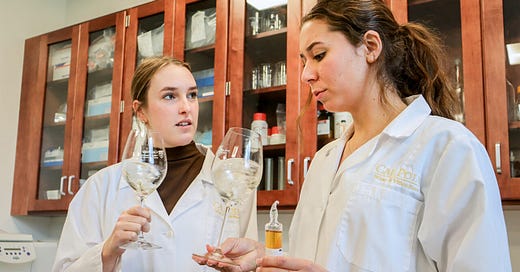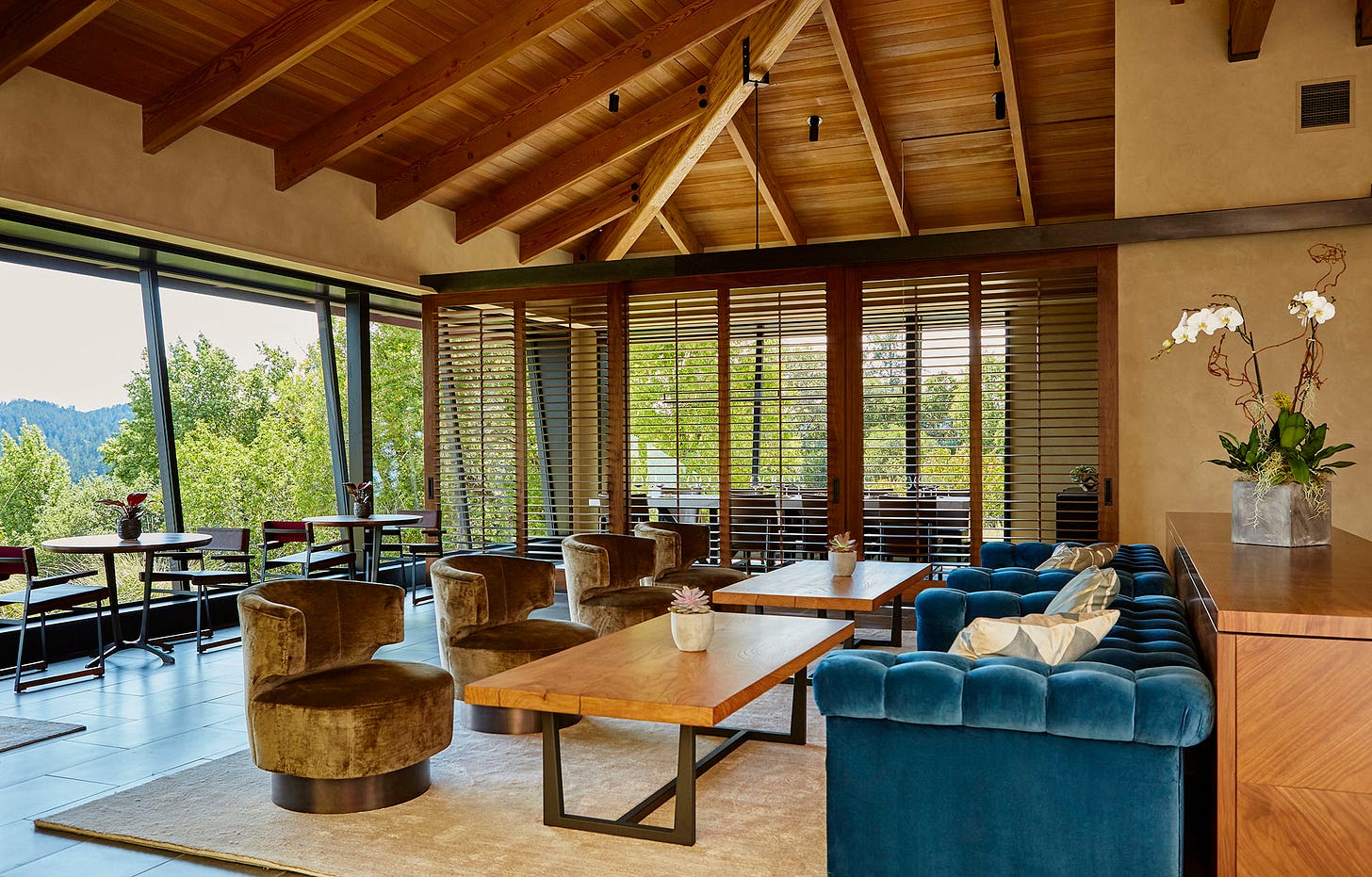The Science of Wine: Somm Series, Gary Farrell Vineyards and Winery
Demystifying a Wine “Tech Sheet”
Gary Farrell Vineyards and Winery, one of my favorite stops in Russian River Valley, Sonoma offers seven unique tasting and education experiences for the wine tourist. One of the most unusual is The Science of Wine from their Somm Series. In today’s interview with Gabe Brezic, Gary Farrell’s Estate Sommelier, he discusses the Somm Series and the reactions of his guests who attend his sessions. He and I are attempting to demystify a wine “Tech Sheet.” Download the Tech Sheet below - an example of a superior award-winning Gary Farrell Pinot Noir, with added term definitions. Forgive the wine geekiness of this newsletter and enjoy a reminder (perhaps) of basic chemistry. Most of all, appreciate how a fine wine is a balance of nature’s chemistry.
Editor’s Note: Interview, February, 4, 2005 with Gabe Brezic, Estate Sommelier, Gary Farrell Vineyards and Winery on YouTube.
Which Science Terms Relate to Wine? What Do They Mean?
A wine ”tech sheet” has some main numeric markers: alcohol, pH, residual sugar, and TA (Titratable acidity). In Gabe Brezic’s “Science of Wine” Somm Series guest experience, he wants to demystify these numbers for his guests and define what the values mean (i.e. why do we feel this is important information to communicate about a wine).
Alcohol: ABV is a measure of the wine’s alcohol percentage by volume, which is generally directly related to the amount of sugar in the grapes when they were harvested. More sugar means more alcohol and vice versa.
What does this tell you? What changes the alcohol content?
*Climate - of the vineyard/place from where the grapes originated affects the sugar content and subsequent alcohol. Warmer climates produce riper grapes with more sugar and vice versa.
*Alcohol content can be a stylistic choice by the winemaker. They may decide to pick the grapes earlier (less sugar) or later (more sugar) depending on their style. If you’re familiar with the region the wine is coming from, you can tell, for example, that a <14% alcohol wine from warm Napa was probably picked earlier.
*Alcohol has a sensory impact. Higher alcohol in wine is also perceived as having more weight and body on the palate, and therefore a bigger, probably bolder wine overall. That’s where balance comes in with acidity being a balancing element.
Acid:
Measuring acidity in a wine is a balancing act between pH and TA.
*pH:
This is a measurement of the intensity of the acidity in a wine. Lower pH numbers mean stronger acidity, but if there’s not a lot of acidity (TA), then you won’t really taste it. Therefore, pH is more for the microbial stability of the wine—unwanted bacteria and microbes won’t grow in wine with a low pH. (Reference: water has a pH of 7 or neutral. The pH of Coca Cola – very acidic – is 2.56. Most wine ranges between 3.0 and 4.0 pH.
*TA (total/titratable acidity):
This is a measurement of the amount of acidity in a wine. The more acidity/the higher TA in a wine, the tarter and/or perceivable that acidity will be on the palate. In a very simplistic sense, TA is for the taste of the wine and pH is for the stability. However, to complicate things, a wine with high TA and high pH won’t taste as tart/acidic as a wine with high TA and low pH, so pH is important to taste as well. Again, it’s all a balancing act and that’s where you hope for a winemaker who knows what they’re doing!
Residual Sugar (RS):
This is a measure of the natural grape sugars (glucose and fructose) leftover in a wine after the alcoholic fermentation finishes. This is different from measuring the grape sugars prior to harvesting. A refractometer in the vineyards helps the winemaker and vineyard manager determine the grape sugars pre-harvest.
*Measured in grams per liter (g/L)
*Dry wines have less than 2 g/L
*A wine containing more than 45 g/L is a “sweet wine.”
* Between 2 g/L and 45 g/L is a broad area of RS that can be considered “off dry.” Buyer Beware: Many wines considered dry really have quite a bit of RS. One popular California Pinot Noir has 6 g/L, a very unusually high amount. Given that a cola can have 106 g/L or 39 g. in a can, it is still low.
Other Things a Wine Tech Sheet Tells You: Vintage, Oak, Aging, Grapes, Place
*Vintage: The year the grapes were picked and perhaps notes about that year’s climate, yield, and harvest time.
*Appellation/AVA***: Where the grapes were picked. The restrictions for labeling of the Appellation or AVA are by law very specific. One of the most restrictive: the State of Oregon specifies that 100% of the grapes must be picked in Oregon to be labeled an Oregon wine or an Oregon AVA.
*Vineyard Designation: a specific estate or group of vineyards may be designated.
*Winemaking: notes might be made on how the wine is vinified, i.e., natural yeasts, whole clusters, cold soak, stainless steel tanks, aging in oak barrels, length of aging.
*Oak in Aging: the tech sheet may specify what % of new vs. neutral oak is used in the aging process.
*Grape Composition: states which grape is used to make the wine. If the wine is a blend, it may specify which % of each grape is used.
*Retail Price
*Release date after bottling
*Tasting Notes: the winemaker (or a sommelier) often includes tasting notes for the wine.
***AVA- American Viticultural Area – a designated grape-growing region. The term “Appellation” is used in the rest of the world to define the geographical area where grapes are grown.
The Science of Wine Experience at Gary Farrell Vineyards: What You Do There?
For this experience each guest received a tasting kit of five Gary Farrell wines and the accompanying tech sheet for them. A table is set with various lab equipment like two different refractometers (manual and digital) and pH paper, as well as table grapes, lemons, oranges, cream of tartar, and a few non-Gary Farrell wines. For the demonstration Gabe Brezic uses the analysis equipment to measure the sugar and acids of the items and wines on the table to talk about how and when decisions are made to harvest grapes (sugar and acid levels) and why that is important to the final wine (aroma, flavor intensity, texture, balance). The non-wine items he uses as a point of reference for people to see what the pH of lemons vs wine vs table grapes are, and the non-Gary Farrell wines were mass market wines to compare “fine wine” with mass-produced wines. The idea was to demystify the tech sheet while also learning about how basic science impacts wine and wine quality.
About Gary Farrell Winery
Beginning in the late 1970s, while working with seminal Russian River Valley vintners such as Davis Bynum, Joe Rochioli, Tom Dehlinger and Robert Stemmler, Gary Farrell was instrumental in showcasing the Pinot Noirs and Chardonnays of the nascent Russian River Valley AVA, a picturesque, redwood-studded wine region 55 miles north of San Francisco, whose mighty river cuts a scenic swath through the heart of Sonoma County. He made his first wine under the Gary Farrell label in 1982 and built the winery into one of the most acclaimed producers of small-lot Pinot Noirs and Chardonnays in the Russian River Valley.
Currently owned and managed by a well-known investor group including Bill Brice of Kistler Vineyards, Pete Scott, former CFO of Beringer Wine Estates, and Walt Klenz, former CEO of Beringer Wine Estates, the team is carefully nurturing Gary Farrell’s legacy of producing small lots of varietally expressive and regionally distinctive Russian River Valley Pinot Noirs and Chardonnays at its beautifully designed winery on Westside Road. In 2023 Brent McKoy succeeded Theresa Heredia as head winemaker. McKoy is celebrating his 20th harvest with Gary Farrell Winery.
Recommended Wines
2021 Gary Farrell Bacigalupi Vineyard Chardonnay, Russian River Valley, $65
This wine features layers of apple blossoms, white peaches, pears, and toasted almonds with a hint of cedar. I bought a half a case for myself!
The vineyard is historic. Its 1973 famed fruit was a substantial part of the grape blend in the Chateau Montelena Chardonnay winner of the “Judgement of Paris” wine tasting in 1976, portrayed in the movie, BottleShock, starring Alan Rickman, Chris Pine, and Bill Pullman. See the Time Magazine 40th anniversary article: “How America Kicked France in the Pants and Changed the World of Wine Forever.”
2019 Gary Farrell McDonald Mountain Vineyard Pinot Noir, Russian River Valley, $75
International Wine Review, 94 Points
This wine has aromas of white pepper, black tea, and fresh herbs in addition to the dried strawberries and pomegranate bouquet. The McDonald Mountain Vineyard itself has cool temperatures, fog, and a diverse clonal selection of Pinot Noir grapes contributing to the wine’s complexity.
Download a Wine Tech Sheet
Wine Wanderings Editorial Calendar
LIVE from Paris, France: Exploring Notre Dame and the Louvre Once More
LIVE from the Seine River: An AmaWaterways Wine River Cruise
LIVE: Excursions along the River Seine on AmaWaterways
10 Tips for Planning Your Next Trip to Paris
What is the Wine Custom Crush Business?
Montalcino: the Italy Story of Brunello and the IGT’s
The Popularity of City Wineries
An Interview with Mike Lewellen, Managing Partner, Lucas & Lewellen Winery, Santa Barbara
Malbec: Domestic and International Finds
The Magic of Tuscany: Touring the Region
Live from Kentucky’s Bourbon Trail: Where to Taste with Tourism Tips
Book Review: Big Macs and Burgundy
In Case You Missed It in the News: Wine Business
The Wall Street Journal, March 13, 2025 “From Champagne to Bourbon, Alcohol Lands on the Front Lines of Global Trade War.”
WineBusiness, March 10, 2025 “Wine Advocacy and Grassroots Marketing: Why Share and Pair Sundays Campaign is Launching this Month.”
Businesswire, March 12, 2025: “Wine Enthusiast Companies Launches Cork+Compass Travel, Offering Exceptional and Exclusive Wine Adventures in Fall 2025.”
Follow Wine Wanderings on Instagram, LinkedIn, Bluesky
Travel Opportunities
****
Cruise with Wine Wanderings: Cruise Travel Reminder: River Seine – Paris – Normandy – Giverny on AmaWaterways- NEXT WEEK
Cruise the Danube on AmaWaterways with Wine Wanderings and Wölffer Estate Winery, April 20, 2026, Romantic Danube.
****







Thank you, Jay Anania for buying me a glass of wine! Tricia